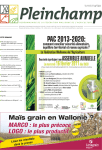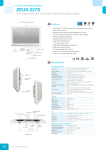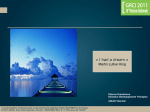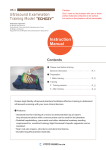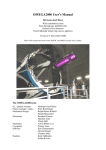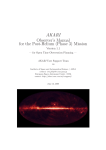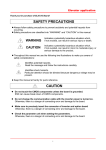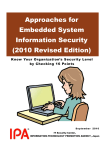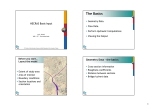Download PDF format
Transcript
Call for Proposals This document is also available in HTML format. Semester S01B: October 15, 2001 -- March 31, 2002 Subaru Telescope, National Astronomical Observatory of Japan Please refer to http://www.naoj.org/Observing/index.html for the latest information. 1. INTRODUCTION AND PROPOSAL ACCEPTANCE POLICY Subaru Telescope invites observing proposals for Semester S01B, which will run from October 15, 2001 until March 31, 2002. The Infrared Camera and Spectrograph (IRCS), Faint Object Camera and Spectrograph (FOCAS), High Dispersion Spectrograph (HDS), Cooled Infrared Spectrograph and Camera (CISCO), OH-Suppression Spectrograph (OHS), and Subaru Prime Focus Camera (Suprime-Cam) will be available for use by visiting observers. Please also refer to http://www.naoj.org/Observing/Instruments/status.html for the detailed current status of these instruments. Although Subaru Telescope is entirely funded by the Japanese government, we also invite proposals from the international community. The actual number of nights to be allocated to international proposals [see note 1] will be determined by the time allocation committee. For the past two semesters, about 10% of the available nights were allocated to such proposals. Non-Japanese researchers are encouraged to submit their proposals in collaboration with Japanese researchers. (1)International proposals are defined as those submitted by non-Japanese principal investigators (PIs) belonging to non-Japanese institutions. Although commissioning of the telescope and instruments will continue through Semester S01B, approximately 47 nights will be allocated for open use during this period. Subaru Telescope asks applicants to understand that, under such circumstances, observations will be carried out in "shared-risk" mode. Loss of telescope time due to telescope or instrument failures will not be compensated. Please be aware that observations in October and November might be affected by possible delays due to the primary mirror repair and surface recoating work scheduled for August and September. Other important information for your proposal preparation is as follows. i. ii. iii. Observing time will be awarded in units of 1 night, up to a maximum of 3 nights. Instrument changes are not permitted during the night. Applicants should refer to the guidelines regarding Guaranteed Time Observations (GTO) in APPENDIX B before submitting a proposal. The Time Allocation Committee has the final say in issues of conflict between GTO and open use observations. 2. OVERVIEW OF OPEN USE SCHEDULE Proposal Deadline: May 15, 2001 5:00pm (JST) Refereeing: June 2001 Time Allocation Committee:July 2001 Telescope Time Scheduling:August 2001 Semester S01B: October 15, 2001 - March 31, 2002 Total number of nights for open use: 47 nights 3. PREPARATION AND SUBMISSION OF PROPOSALS Prospective applicants must fill in the Application Form for Telescope Time (3 pages plus 1 page for additional targets, if required) and prepare a Scientific Justification of not more than 2 pages of A4 or letter size paper. These documents should be prepared in English, although a Japanese translation (i.e., no new information) of the scientific justification may also be included. Please use a text font no smaller than 10 point. Send: To: 17 copies of 1. Application Form for Telescope Time (3 pages) 2. Science Justification (with Japanese translation if necessary) Dr Motohide Tamura Subaru Project Office National Astronomical Observatory Osawa 2-21-1, Mitaka, Tokyo 181-8588, Japan To arrive by:Proposal Submission deadline: 5:00pm, May 15, 2001 (JST) Please write:Subaru Telescope Proposal in red ink on the envelope. 4. HOW TO COMPLETE THE APPLICATION FORM All proposals will be subject to technical review by observatory staff, who will use Pages 2 and 3 for this purpose. Upon acceptance the entire proposal, including scientific justification, will be passed to the support astronomer for preparation of observations. 4-1. Title of Proposal Provide a short title for your proposal. 4-2. Principal Investigator Provide contact details for the PI. The observatory will contact the PI with any questions regarding the proposal or observations. 4-3. Scientific Category Please check one and only one category from the 5 listed (see APPENDIX A). Each proposal will be reviewed by a panel of 5 referees who are experts in the appropriate category. 4-4. Abstract Provide a clear and concise description of your proposed observations and their scientific importance. 4-5. Co-Investigators List the names of co-investigators. There will be limited travel support for researchers and graduate students who belong to Japanese institutions. All potential observers must be listed here. 4-6. List of Applicant's Related Publications List (with full citation) publications from the last 5 years related to the proposal. 4-7. Thesis Work If the observations will form part of a graduate student's thesis project, please provide the student's name and thesis title. 4-8. Title of Proposal Duplicate the title of the proposal for technical reviewers. 4-9. Observing Run List the instruments (IRCS, FOCAS, HDS, CISCO, OHS, or Suprime-Cam), requested nights (1, 2, or 3), preferred month(s), lunar phase (Bright, Gray or Dark), and Observing Modes. Dark time is defined as being within 3 nights of the New Moon, and Bright time is within 3 nights of the Full Moon; Gray time is the remaining part of the lunar cycle. Applicants who request Dark time for IRCS, CISCO, or OHS observations should justify this in their scientific justification. Put the total number of requested nights in the box. 4-10. List of Targets List all the proposed targets. J2000 is recommended for the equinox. Use an additional sheet if necessary. Please check the box if you do not want to expose your target names for the technical review by the support astronomer. 4-11. Scheduling Requirements Any special scheduling requirements should be explained here. 4-12. Instrument Requirements Specific or unusual instrument requirements should be explained here. 4-13. Experience Describe your experience, ability, and need of any assistance, etc., for observing and data reduction in order for your support astronomer to better help you prepare and make observations. 4-14. Backup Proposal in Poor Conditions Provide a short description of observations which will be carried out if conditions are not good enough for the main proposal (e.g., poor transparency). Please specify target names to ensure there are no conflicts with GTO targets. 4-15. Observing Method and Technical Details Justify the time requested by describing the details of your proposed observations in this section, with reference to the instrument sensitivities provided on the web site. Please give sufficient information so that the feasbility of the proposed observations can be determined, and so support astronomers can prepare the observations if the proposal is accepted. 4-16. Proposal Status Check the box if the proposed observations are a continuation of previous observations (whether successful or not). Please give the proposal ID number of the previous proposal. 5. MEMBERS OF THE TIME ALLOCATION COMMITTEE Chair: Sadanori Okamura (University of Tokyo, Structure Formation and Cosmology) Coordinator: Yoshiaki Taniguchi (Tohoku University, External Galaxies and AGN) Members: Junichi Watanabe (NAOJ, Solar System) Kozo Sadakane (Osaka Kyoiku University, Stars and the Galaxy) Motohide Tamura (NAOJ, Star and Planet Formation and Interstellar Matter) Nobuo Arimoto (University of Tokyo, General) Nobuyuki Kawai (Tokyo Institute of Technology, General) Tetsuo Hasegawa (NAOJ, General) 6. STATUS OF TELESCOPE The latest telescope performance figures can be found at http://www.naoj.org/Observing/Telescope/performance.html. If you have any specific questions related to application for S01B, please contact Dr. Tomonori Usuda [Subaru Telescope] ([email protected]). 6-1. Image quality Image quality as good as 0.2'' in the near-infrared and 0.3'' in the optical and mid-infrared have been achieved. When the wind speed at the mirror exceeds 1-2 m/s, some image degradation may occur and the windscreen is needed. 6-2. Target acquisition The r.m.s. absolute pointing accuracy of Subaru is better than 1''. More accurate target acquisition can be obtained with the acquisition and guide (AG) probe, which can position a target to 0.07'' accuracy within its 30'' field of view. 6-3. Tracking/guiding performance The tracking (i.e., no guide star) accuracy of Subaru Telescope is typically 0.1'' for integrations of 1 minute. This degrades to 0.2'' over 10 minutes, and 0.6'' over 30 minutes under the best conditions. The guiding accuracy is typically about 0.12'' and stars down to V=18 have successfully been used at the Cassegrain focus. The performance at other foci has not yet been finally determined and is to be updated in the web pages. 6-4. Other performance i. ii. At the Cassegrain and Nasmyth foci, the Z-position of the secondary mirror is changed with 0.1 mm accuracy to automatically refocus the telescope when the temperature at the torus changes. The Atmospheric Dispersion Corrector (ADC) works normally at wavelengths from 360-1000 nm at the Cassegrain, Nasmyth Optical, and Prime foci. 7. STATUS OF INSTRUMENTS IRCS, FOCAS, HDS, CISCO, OHS , and Suprime-Cam will be available for open use in Semester S01B. All potential applicants should refer to http://www.naoj.org/Observing/Instruments/index.html for the latest instrument performance figures and http://www.naoj.org/Observing/Instruments/status.html for their current and planned status. If you have any questions about the instruments and their status, please contact the support astronomer (S.A.) of each instrument. Subaru Telescope does not support the use of user filters for Open Use programs. However, a limited number of user filters may be accepted for some instruments (see below) provided that the filters satisfy all the instrument requirements. It may take a long time to verify that a filter meets the requirements. Note also that Subaru telescope cannot compensate for any damage to filters caused during setup and observation. 7-1. IRCS S.A. Dr. Hiroshi Terada, Subaru Telescope ([email protected]) IRCS will be available for imaging and grism spectroscopy with the 58 mas plate scale, and for echelle spectroscopy. The imaging and grism spectroscopy performances will be greatly improved as a new ALADDIN III array will be installed in IRCS over the summer. The IRCS instrument web pages reflect the anticipated performance of the new array. A limited number of user filters can be accepted. You must contact Hiroshi Terada prior to proposal submission for detailed specifications. User filters must be ready by the end of July, and may not be returned until late 2002. 7-2. FOCAS S.A. Dr. Youichi Ohyama, Subaru Telescope ([email protected]) FOCAS will be available for imaging and long-slit spectroscopy. A maximum of 3 proposals requesting multi-object spectroscopy will also be accepted. Applicants interested in MOS observations must read the instructions at http://www.naoj.org/Observing/Instruments/FOCAS/spec/mos.html. A limited number of user filters may be accepted. If you wish to use your own filters, please contact Youichi Ohyama for detailed information before submitting your proposal. The vignetting problem caused by the AO mounting flange which currently affects guiding will be fixed by the start of Semester S01B. 7-3. HDS S.A. Dr. Wako Aoki, NAOJ, Mitaka ([email protected]) HDS will be available for optical echelle spectroscopy. A limited number of user filters for blocking unwanted orders in longslit mode may be accepted; please contact Wako Aoki for specifications before submitting your proposal. 7-4. CISCO S.A. Dr. Kentaro Motohara, Subaru Telescope ([email protected]) CISCO is expected to be available for broad and narrow-band near-infrared imaging and low-resolution spectroscopy for at least the months of December through February. At the start and end of the semester, depending on demand, CISCO will be unavailable as the IR Nasmyth platform will be configured for OHS. No user filters will be accepted for CISCO observations. 7-5. OHS S.A. Dr. Kentaro Motohara, Subaru Telescope ([email protected]) OHS will be available for sensitive low-resolution JH-band spectroscopy. The exact period when the IR Nasmyth platform is configured for OHS will be determined by the schedule after the Time Allocation Committee meeting. Please indicate clearly if your OHS or CISCO observations are strongly time-constrained. No user filters will be accepted for OHS observations. 7-6. Suprime-Cam S.A. Dr. Yutaka Komiyama, Subaru Telescope ([email protected]) The replacement of the Suprime-Cam CCDs with MIT/LL chips will occur in April 2001. The expected performance with the new CCDs is listed in the instrument web pages. A limited number of user filters for Suprime-Cam may be accepted. If you wish to bring your own filters, please contact Yutaka Komiyama for detailed information before submitting your proposal. 8. DATA RIGHTS AND ARCHIVING Successful applicants will have exclusive access to their data for a period of 18 months from the time of observation, after which the data will be freely available from the Subaru archive. Applicants may request an extension to this proprietary period in their Scientific Justification, but such an extension will only be awarded in exceptional circumstances. APPENDIX A Category Keywords List and Remarks 1. Solar System Planets, satellites, asteroids, comets, Kuiper Belt objects, Oort cloud, interplanetary medium, zodiacal light 2. Stars and the Galaxy Individual stars (including brown dwarfs), main sequence and post-MS stars, Wolf-Rayet stars, variable and peculiar stars, novae, white dwarfs (including the central stars of planetary and protoplanetary nebulae), neutron stars, pulsars, supernovae, star clusters and associations, Galactic structure 3. Star Formation and the Interstellar Medium Young stellar objects and disks, gas and dust properties, extrasolar planets and brown dwarfs, molecular and interstellar clouds, stellar jets and outflows, H II regions, planetary and protoplanetary nebulae, reflection nebulae, supernova remnants, cosmic rays, magnetic fields, Galactic center 4. External Galaxies and AGN Individual galaxies, groups and clusters of galaxies, starburst galaxies, AGN, quasars, galactic jets 5. Structure Formation and Cosmology Cosmological parameters, large scale structure, peculiar velocities, distance scale, dark matter, gravitational lensing, distant galaxies, distant clusters, deep surveys, quasar absorption line systems, intergalactic medium Important Remarks Some proposals may appear to be equally suited to more than one category. In such cases, the applicant should select a category based on the scientific aims of the proposal rather than the target objects. In order to ensure fair refereeing, and that similar proposals are refereed by the same panel, the applicant's choice of category may be overruled. APPENDIX B: CONFLICTS WITH GUARANTEED TIME OBSERVATIONS A number of nights have been reserved for Guaranteed Time Observations. This Appendix lists those observations which might conflict with targets proposed for Open Use in Semester S01B, or already observed in Guaranteed Time. All coordinates in this Appendix are J2000.0. APPENDIX B1: IRCS There are no protected targets for IRCS observations, but applicants may not propose to use IRCS to duplicate CISCO/OHS observations. APPENDIX B2: FOCAS Applicants are prohibited from performing imaging or spectroscopy of any of the following sources or fields with FOCAS. Name RA dec M 82 09 55 52.200 +69 40 47.00 PG 1115+080 11 18 17.000 +07 45 59.00 SDF (2'x2' field) 13 24 21.300 +27 29 23.00 HST J14176+5226 14 17 36.300 +52 26 44.00 Arp 220 15 34 57.100 +23 30 11.00 APPENDIX B3: HDS There are no protected targets for HDS observations. However, the following objects have already been observed by the HDS team and these observations should not be duplicated. The instrument setup is described in the HDS User Manual. Name RA dec Setup Exp (s) CS 22183-31 01 09 04.9 -04 42 25 Ba 9751 CS 29526-110 03 27 43.6 -23 00 31 Bc 5400 HD 24289 03 51 54.5 -03 49 11 Ra 7200 CS 22169-25 04 16 05.6 -14 34 02 Ba 5400 HD 250290 06 01 07.7 +23 18 18 Bc 6000 Ra 13084 07 20 59.0 +24 59 58 Bc 3900 APM 08279+5255 08 31 41.6 +52 45 17 Ya 13678 BS 16469-075 10 15 10.6 +42 53 19 Bc 5400 BS 16920-17 12 07 17.1 +41 39 35 Bc 5400 BM Gem BS 16928-053 12 22 28.1 +34 11 24 Bc 5400 BS 16929-005 13 03 29.4 +33 51 06 Bc 5400 BS 16082-129 13 47 11.5 +28 57 46 Bc 5400 HD 126587 14 27 00.4 -22 14 39 Bc 4500 CS 22952-15 23 37 28.6 -05 47 56 Ba 9000 APPENDIX B4: CISCO The following targets have already been observed with CISCO. Applicants should not duplicate these observations without substantial justification. Name RA dec Reference Abell 851 09 42 56.600 +46 59 22.00 Iye et al. (2000; PASJ, 52, 9) PG 1115+080 11 18 17.000 +07 45 59.00 Iwamuro et al. (2000; PASJ, 52, 25) BR 1202-0725 12 05 23.110 -07 42 32.50 Ohta et al. (2000; PASJ, 52, 557) HDF-N 12 36 49.400 +62 12 58.00 Iwamuro et al. (2000; PJAS, 52, 73) Subaru Deep Field 13 24 21.380 +27 29 23.00 Nakajimi et al. (astro-ph/0008004) Maihara et al. (astro-ph/0009409) 3C 324 Yamada et al. (2000; PASJ, 52, 43) 15 19 48.900 +21 25 38.10 Kajisawa et al. (2000; PASJ, 52, 53) Kajisawa et al. (2000: PASJ, 52, 61) Charon Nakamura et al. (2000; PASJ, 52, 551) APPENDIX B5: OHS The following objects have already been observed, or will be observed in Semester S01B, with OHS and the JH grism. Those targets yet to be observed (indicated by an empty value in the exposure time column) are strictly embargoed. Radio galaxies: to study the ionization mechanism along the alignment axis and the stellar population of the host galaxy. Name RA dec Exp (s) PKS 0156-252 01 58 33.600 -24 59 31.00 4000 PMN J0214-1158 02 14 17.400 -11 58 45.00 4000 PMN J0408-2418 04 08 51.500 -24 18 16.00 6000 4C +41.17 06 50 52.100 +41 30 31.00 4000 4C +43.15 07 35 21.900 +43 44 20.00 4000 TXS 0828+193 08 30 53.400 +19 13 16.00 4000 MG2 J090533+3407 09 05 30.100 +34 07 57.00 4000 6C 1232+39 4000 12 35 04.700 +39 25 38.00 4C -00.54 14 13 15.100 -00 23 01.00 3000 4C -00.62 16 01 17.300 -00 28 47.00 4000 Quasars: to study FeII and MgII evolution in high-redshift quasars. Name RA BR 0019-1522 dec Exp (s) 00 22 08.000 -15 05 39.00 4000 SDSSp J010619.25+004823.4 01 06 19.200 +00 48 23.00 4000 SDSSp J021043.17-001818.4 02 10 43.170 -00 18 18.40 4000 SDSSp J021102.72-000910.3 02 11 02.700 -00 09 10.00 6000 SDSSp J031036.97-001457.0 03 10 37.000 -00 14 57.00 4000 SDSSp J033829.31+002156.3 03 38 29.300 +00 21 56.00 4000 SDSSp J102119.16-030937.2 10 21 19.160 -03 09 37.20 2000 BR 1033-0327 10 36 23.700 -03 43 20.00 2000 SDSSp J112956.10-014212.4 11 29 56.100 -01 42 12.40 2000 SDSSp J120441.73-002149.6 12 04 41.730 -00 21 49.60 4000 SDSSp J120823.82+001027.7 12 08 23.820 +00 10 27.70 4000 PC 1247+3406 2000 12 49 42.110 +33 49 52.30 Other targets: (mostly) to study star formation rates with the [OII] line and the stellar population with the Balmer jump. Name RA Exp (s) MLG93 G2/G4 00 03 28.600 -26 03 52.00 8000 BTM98 cK39W 01 52 30.800 +33 50 55.00 5000 PKS 0201+113 B13 02 03 49.300 +11 36 11.00 4000 HE 1104-1805 11 06 33.700 -18 21 25.00 5000 SMM J14011+0252 J1/J2 14 01 04.910 +02 52 24.95 4000 SMM J14011+0252 J6/J7 14 01 03.049 +02 53 12.75 4000 APPENDIX B6: Suprime-Cam • dec 7 high Galactic latitude fields: o 01 14 51 +20 55 56 o 02 18 00 -05 12 00 o 12 34 02 -13 18 36 (1 deg square) o 12 57 35 +66 49 44 o 13 24 21 +27 29 23 o 14 27 15 +64 24 33 16 04 20 +43 10 00 (3 deg square) 6 fields in Coma: o 12 57 07.5 +28 38 12.5 o 12 57 07.5 +29 03 12.5 o 12 57 07.5 +28 27 42.5 o 12 57 07.5 +28 52 42.5 o 12 58 15.0 +27 46 12.5 o 12 59 23.7 +27 51 12.5 2 fields in Virgo: o 12 25 46.0 +12 43 00 o 12 24 46.0 +13 06 00 2 fields in Hydra: o 10 35 53.0 -27 23 30 o 10 35 05.0 -28 23 00 12 galaxy clusters: o CL 0024 (00 26 36 +17 09 43) o A 222 (01 37 33 -12 59 26) o A 223 (01 37 55 -12 48 57) o A 665 (08 30 59 +65 50 43) o A 963 (10 17 12 +39 00 00) o A 1401 (11 51 53 +37 16 12) o A 1689 (13 11 29 -01 20 29) o A 2009 (15 00 15 +21 22 09) o A 2069 (15 23 57 +29 53 26) o A 2218 (16 35 54 +66 13 00) o MS 1520.1+3002 (15 22 13 +29 51 59) o ClG J0848+4452/3 (08 48 00 +44 54 00) Leo II (11 13 27 +22 09 40) o • • • • •












